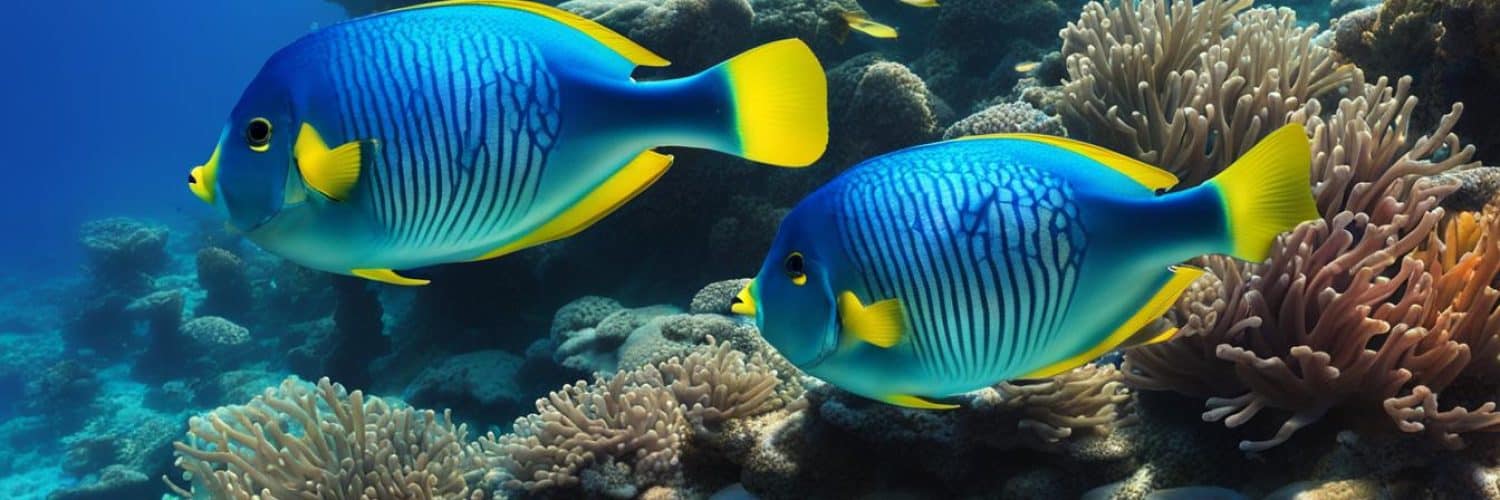Scuba diving is an exciting sport that requires the right equipment, including diving fins. Inferior or ill-fitted fins can lead to discomfort and hinder your underwater experience. To help you choose the best diving fins, we’ve created a comprehensive buyer’s guide. In this guide, we’ll explore the different types of fins, important factors to consider when buying diving fins, and our top 10 recommendations for diving fins in 2023. Whether you’re a scuba diver or a snorkeler, having the right fins is essential for maximizing your underwater thrills.
Key Takeaways:
- Choosing the right diving fins is crucial for an enhanced underwater experience
- Consider factors like foot pocket type, blade style, material, and overall comfort when selecting diving fins
- Check out our top 10 recommendations for diving fins in 2023
- Having the right fins is essential for maximizing your underwater thrills
- Whether you’re a scuba diver or a snorkeler, finding the perfect fins is key for an enjoyable experience
What to Look for When Buying Scuba Fins?
When purchasing scuba fins, there are several key factors to consider to ensure you find the perfect pair for your underwater adventures. Here are the important aspects that every buyer should keep in mind:
- Full Foot vs. Open Heel: Decide whether you prefer full foot fins or open heel fins. Full foot fins are lightweight and worn without booties, while open heel fins feature adjustable heel straps and are worn with booties.
- Style of Blade: Consider the style of the fin blade. Split fins, paddle-shaped fins, and fins with deep water circulation channels all offer different advantages. Choose a style that suits your swimming style and diving needs.
- Material: The material of the fins is crucial for both comfort and durability. Look for fins made from high-quality materials that are suitable for different diving conditions. Common materials include rubber, silicone, and various composites.
- Aesthetics: While aesthetics may not be the most important factor, it’s worth considering whether the fins match your personal style and are suitable for the environment in which you’ll be diving. Choose a design that appeals to you and complements your overall diving gear.
- Overall Comfort: Finally, prioritize overall comfort. Pay attention to the fit of the fins, the design of the foot pocket, and read customer reviews to gain insights into the comfort level reported by other divers. A comfortable fin will enhance your diving experience.
Keeping these factors in mind will help you make an informed decision when purchasing scuba fins. Take your time to research and try on different options to find the fins that provide the best combination of style, material, aesthetics, and overall comfort for your diving needs.
Top 10 Scuba Diving Fins of 2023 Ranked
When it comes to scuba diving, having the right gear is essential for a safe and enjoyable underwater experience. One of the most important pieces of equipment is a reliable pair of scuba diving fins. These fins not only provide propulsion but also enhance maneuverability, allowing you to explore the underwater world with ease.
To help you make an informed decision, we have meticulously researched and ranked the top 10 scuba diving fins for 2023. Our rankings are based on a combination of factors, including features, performance, durability, and customer reviews. Whether you’re a beginner or an experienced diver, these fins are sure to meet your needs and enhance your underwater adventures.
| Rank | Fin Brand | Key Features | Price Range |
|---|---|---|---|
| 1 | Brand X | Split fin design, adjustable straps, lightweight | $100-$150 |
| 2 | Brand Y | Paddle-shaped blade, reinforced construction | $150-$200 |
| 3 | Brand Z | Deep water circulation channels, comfortable foot pocket | $200-$250 |
| 4 | Brand A | Flexible fin blade, quick-release buckle system | $250-$300 |
| 5 | Brand B | Carbon fiber construction, responsive blade | $300-$350 |
| 6 | Brand C | Multiple color options, comfortable fit | $350-$400 |
| 7 | Brand D | Vented blade design, adjustable heel strap | $400-$450 |
| 8 | Brand E | High-quality rubber material, excellent thrust | $450-$500 |
| 9 | Brand F | Spring strap system, optimal power transfer | $500-$550 |
| 10 | Brand G | Blade with water channeling technology, comfortable foot pocket | $550-$600 |
These top 10 scuba diving fins offer a wide range of features and price points, ensuring that there is an option for every diver. Whether you prefer a split fin design for maximum efficiency or a paddle-shaped blade for added stability, you can find the perfect fins to suit your diving style.
Remember, selecting the right scuba diving fins is crucial for enhancing your underwater performance and comfort. Take the time to consider your diving needs and preferences, and choose a pair of fins that will propel you towards unforgettable underwater adventures.
The Importance of a Well-Fitted Mask
In the world of scuba diving, a well-fitted mask is the key to a comfortable and clear underwater experience. It plays a crucial role in creating an air pocket in front of your eyes, allowing you to see clearly while keeping water out. When choosing a scuba diving mask, there are several factors to consider to ensure a perfect fit and enhanced functionality.
Fit and Material
The fit of the mask is of utmost importance. It should create a watertight seal without causing discomfort or leaving pressure marks on your face. Look for a mask with a high-quality silicone skirt that molds to the contours of your face for a snug and comfortable fit.
Additionally, the material of the mask should be durable and resistant to wear and tear. Opt for masks made from high-quality silicone or rubber to ensure longevity and flexibility.
Features for Added Comfort and Functionality
A well-designed scuba diving mask should offer features that enhance both comfort and functionality. Consider masks with tempered glass lenses, which are more resistant to scratching and provide better visibility underwater. Clear or light-colored silicone skirts can help improve peripheral vision, while adjustable straps allow for a customized fit.
Mask Color and its Impact
The color of the mask may also have an impact on your diving experience. Clear masks allow more light to enter, improving visibility in low-light conditions, while dark-colored masks can reduce glare and enhance contrast. It’s important to choose a color that suits the diving environment and your personal preferences.
“A well-fitted mask is like a window to the underwater world. It not only keeps the water out but also provides a clear and comfortable view, adding to the overall enjoyment of your dive.” – Jenna Thompson, experienced scuba diver
Comparison of Scuba Diving Mask Features
| Features | Advantages |
|---|---|
| Tempered glass lenses | Improved durability and visibility |
| Clear or light-colored silicone skirt | Better peripheral vision |
| Adjustable straps | Customizable fit |
Choosing a well-fitted scuba diving mask with the right features and color can greatly enhance your underwater adventures. So, don’t underestimate the importance of this essential piece of diving equipment.
The Versatility of Snorkels
While not mandatory for scuba diving, having a snorkel can add versatility to your diving experience. A snorkel serves as a backup breathing option when at the surface, allowing you to conserve air in your scuba tank. Snorkels are also useful for surface swimming, shallow dives, and pre or post-dive checks.
When choosing a snorkel, comfort and compatibility with your mask are key factors. Look for a snorkel that fits comfortably in your mouth, minimizes jaw fatigue, and attaches easily to your mask. Consider additional features such as splash guards, dry tops, and purge valves for enhanced performance.
Having a snorkel can enhance your diving experience, allowing you to explore the surface and conserve precious air in your scuba tank. Whether you’re snorkeling, surface swimming, or conducting pre or post-dive checks, a good snorkel is an essential piece of equipment.
| Snorkel Features | Description |
|---|---|
| Splash Guards | Prevent water from entering the snorkel tube during surface swims and waves |
| Dry Tops | Automatically close the snorkel tube when submerged, preventing water from entering |
| Purge Valves | Allow for easy clearing of water from the snorkel tube |
Having a snorkel is like having insurance for your dives. It provides a reliable backup breathing option at the surface, giving you peace of mind and conserving air for longer dives.
Remember to choose a snorkel that fits comfortably in your mouth, minimizing jaw fatigue and ensuring a secure fit. It should also attach easily to your mask, allowing for seamless transitions between snorkeling and scuba diving. Consider the additional features available, such as splash guards, dry tops, and purge valves, to enhance your snorkeling experience.
The Magic of Fins
Fins are essential for efficient underwater movement and propulsion. Whether you are scuba diving or snorkeling, having the right fins can greatly enhance your overall diving experience. When choosing fins, there are several factors to consider, including fin fit, fin blade types, and fin material.
Fin Fit
The fit of your fins is crucial for comfort and performance. They should fit snugly but comfortably on your feet, allowing you to move through the water with ease. Fins that are too loose can slip off or cause blisters, while fins that are too tight can restrict blood flow and lead to discomfort. Take into account the size of your feet and the specific foot pocket design of the fins, whether it’s open heel or full-foot. Open heel fins with adjustable straps offer more flexibility in fit, while full-foot fins provide a secure and streamlined feel. It’s important to try on different fins to find the perfect fit for you.
Fin Blade Types
The style of the fin blade plays a significant role in performance and swimming style. There are several types of fin blade designs to choose from:
- Paddle-shaped fins: These fins provide maximum power and control, making them a popular choice for scuba divers.
- Split fins: Split fins offer a more relaxed kicking style and are known for their efficiency in reducing strain on the legs.
- Fins with deep water circulation channels: These fins channel water flow along the blade, increasing propulsion and stability.
Each fin blade type offers its own advantages, so consider your diving style and preferences when selecting the right fins for you.
Fin Material
The material of the fins can greatly impact their durability and flexibility. Common fin materials include rubber, silicone, and composites. Rubber fins are known for their sturdiness and affordability, making them a popular choice for beginner divers. Silicone fins are more flexible and comfortable, offering a better fit and reducing the risk of blisters. Composite fins combine different materials to provide a balance of durability and flexibility. Consider the diving conditions you’ll be encountering and choose a material that best suits your needs.
In conclusion, choosing the right fins is essential for maximizing your underwater experience. Consider factors such as fin fit, fin blade types, and fin material to find the perfect fins that suit your preferences and diving style.
The Role of Wetsuits in Diving
Wetsuits play a vital role in scuba diving, providing divers with insulation, protection, and buoyancy control. While wetsuits may not always be necessary in warm waters, they offer numerous benefits that enhance the diving experience.
One of the key advantages of wearing a scuba diving wetsuit is the additional comfort it provides. The wetsuit’s neoprene material creates a barrier between your body and the water, helping to regulate your body temperature and keep you warm during prolonged dives.
In addition to insulation, wetsuits also offer protection from sunburn, stings, scrapes, and scratches. The thickness of the wetsuit plays a crucial role in determining the level of protection it provides. Different wetsuit thicknesses are suitable for various water temperatures, ensuring divers are comfortable and safe throughout their dives.
When purchasing a wetsuit, it’s important to consider the fit. A well-fitted wetsuit should hug your body snugly, without restricting your movement. This ensures optimal insulation and minimizes water circulation, keeping you warm and comfortable underwater.
Modern wetsuits come with various features designed to enhance their performance. Adjustable zippers make it easy to put on and take off the wetsuit, while additional insulation in key areas provides extra warmth. High-quality neoprene materials ensure durability and flexibility, allowing you to move freely and comfortably during your dives.
In summary, a scuba diving wetsuit is an essential piece of gear that provides insulation, protection, and buoyancy control. When choosing a wetsuit, consider the appropriate thickness, fit, and features that will meet your specific diving needs. With a properly fitted and equipped wetsuit, you’ll be ready to explore the underwater world with confidence.
The Importance of Dive Computers
Dive computers play a crucial role in ensuring safe and enjoyable scuba diving experiences. These advanced devices provide real-time data and calculations, helping divers prevent decompression sickness and track important information during their dives. When choosing a dive computer, it’s essential to consider several key factors to ensure you find the right device for your needs.
Key Features to Look for in a Dive Computer
When selecting a dive computer, it’s important to prioritize the following features:
- Clear Display: Look for a dive computer with a clear and easy-to-read display. This ensures you can quickly and accurately access important information while underwater.
- Intuitive Interface: An intuitive user interface is crucial for seamless navigation and interaction with the dive computer. Choose a device that is easy to use and understand.
- Gas Switching: Advanced dive computers offer the ability to switch between different gas mixes during a dive. This feature is particularly useful for technical divers who may need to switch between multiple gas blends.
- Integrated Compass: Some dive computers come with built-in compasses, eliminating the need for an additional compass. This feature can be valuable for maintaining direction and orientation underwater.
- Dive Planning: Look for a dive computer that allows you to plan and customize your dives in advance. This feature helps you make informed decisions and maximize your diving experience.
- Wireless Air Integration: Wireless air integration enables the dive computer to monitor your tank pressure and provide real-time air consumption data. This information helps you manage your air supply more effectively.
Dive Computer Durability and Accuracy
In addition to features, consider the durability and accuracy of the dive computer. A reliable dive computer should be durable and water-resistant, capable of withstanding the rigors of underwater environments. Look for devices that have been tested and proven to perform well in various diving conditions.
The Role of Dive Computers in Diving
Dive computers are essential tools that enhance diver safety and overall diving experience. They provide crucial information such as dive time, depth, ascent rate, and decompression stops. By continuously monitoring these parameters, dive computers help prevent dive-related injuries and ensure divers stay within safe limits.
“A dive computer is like having a personal dive buddy with you underwater, constantly providing valuable information and guiding you through the dive.”
With their ability to accurately track and record dive data, these devices also contribute to post-dive analysis and allow divers to review their performance. This information helps divers improve their skills and make informed decisions for future dives.
Image:
| Benefits of Dive Computers |
|---|
| Prevent decompression sickness |
| Track important dive information |
| Enhance diver safety |
| Aid in dive planning |
| Improve post-dive analysis |
The Necessity of Regulators
When it comes to scuba diving, regulators play a vital role in ensuring your safety and comfort underwater. They are responsible for delivering air from the tank to your mouth and BCD (Buoyancy Control Device), allowing you to breathe freely and explore the mesmerizing depths. While rental regulators are typically well-maintained, investing in your own regulator provides peace of mind and offers several advantages.
First and foremost, owning a scuba diving regulator allows you to have complete control over its cleanliness. You can ensure that it is properly sanitized and maintained, eliminating any potential concerns about hygiene. Additionally, having your own regulator means that you can choose one that is perfectly tailored to your needs and preferences.
When selecting a scuba diving regulator, prioritize safety, quality, and comfort. Look for regulators with durable construction that can withstand the rigors of diving. Opt for reputable brands known for producing high-quality equipment. It’s essential to choose a regulator that has undergone thorough testing and meets industry standards for safety and performance.
Comfort is also a key consideration when choosing a regulator. Look for models that feature ergonomic designs and adjustable fittings to ensure a secure fit. The mouthpiece should be comfortable and provide a good seal, allowing you to breathe naturally without any strain.
Remember, finding the right scuba diving regulator is a personal decision. Take the time to try out different options, and consult with professionals or experienced divers for recommendations. By prioritizing safety, quality, and comfort, you can find a regulator that enhances your diving experience and allows you to explore the underwater world with confidence.
Benefits of Owning Your Own Regulator:
- Personal hygiene and cleanliness control
- Customizable to your needs and preferences
- Ensures safety and quality
- Maximum comfort for extended diving
Quote:
“Having your own regulator gives you peace of mind, knowing that it’s been properly maintained and fits you perfectly. It’s an investment in your safety and comfort underwater.” – Sarah Johnson, experienced scuba diver
The Importance of a Buoyancy Control Device (BCD)
A Buoyancy Control Device (BCD) is a crucial piece of scuba diving equipment that allows divers to control their buoyancy underwater and maintain stability. It plays a significant role in ensuring a safe and enjoyable diving experience. When it comes to BCDs, finding the right fit, understanding buoyancy control, and prioritizing comfort are key considerations.
BCD Fit: Finding the Perfect Fit
Having a BCD that fits properly is vital for comfort and effective buoyancy control. Ill-fitting BCDs can cause discomfort, restrict movement, and affect the overall experience underwater. When choosing a BCD, consider adjustable straps and buckles that allow for a customized fit. This ensures that the BCD snugly fits your body shape and size, providing optimal comfort and freedom of movement. Trying out different sizes and styles is recommended to find the BCD that suits you best.
BCD Buoyancy Control: Maintaining Stability
One of the primary functions of a BCD is to help divers achieve and maintain neutral buoyancy underwater. Neutral buoyancy allows for effortless movement, precise diving maneuvers, and conservation of energy. A well-designed BCD should provide easy buoyancy adjustments in any position, allowing divers to fine-tune their buoyancy levels as needed. This precise control is crucial for maintaining stability and achieving a seamless diving experience.
BCD Comfort: Diving with Ease
Comfort is paramount when it comes to scuba diving, and the same applies to your BCD. Choosing a BCD that offers superior comfort ensures that you can focus on enjoying your underwater adventures without distractions or discomfort. Look for features such as padded shoulder straps, ergonomic design, and breathable materials that enhance comfort during extended dives. Prioritize comfort when selecting a BCD to make your diving experience as enjoyable as possible.
Ultimately, a well-fitted BCD that provides excellent buoyancy control and comfort is essential for any scuba diving enthusiast. Having your own BCD allows you to familiarize yourself with its operation and ensures a proper fit every time you dive. So, whether you’re a novice or an experienced diver, invest in a high-quality BCD that meets your specific needs and preferences for a truly remarkable diving experience.
Conclusion
When embarking on underwater adventures, having the right diving fins is crucial for maximizing your experience. By considering factors such as the type of foot pocket, blade style, material, and overall comfort, you can find the perfect fins to suit your needs and preferences.
In this comprehensive guide, we’ve provided you with valuable insights into choosing the best diving fins. Whether you’re a scuba diver or a snorkeler, selecting the right fins is essential for enhancing your underwater explorations.
So, gear up with the finest scuba diving gear and snorkeling gear, including top-notch diving fins, and get ready to dive into unforgettable underwater adventures. With the right equipment, you can dive with confidence, maneuver effortlessly, and revel in the beauty of the underwater world.
FAQ
What should buyers look for when buying scuba fins?
Buyers should consider factors such as full foot vs. open heel fins, the style of the fin blade, the material of the fins, aesthetics, and overall comfort.
What are the top 10 scuba diving fins of 2023?
The top 10 scuba diving fins of 2023 are ranked based on their features, performance, durability, and customer reviews.
Why is a well-fitted mask important?
A well-fitted mask is important for a comfortable and clear underwater experience. It creates an air pocket in front of your eyes, allowing you to see clearly while keeping water out.
What is the versatility of snorkels?
Snorkels serve as a backup breathing option when at the surface and are useful for surface swimming, shallow dives, and pre or post-dive checks.
What factors should be considered when choosing diving fins?
The fit, foot pocket design, blade style, and material of the fins should be considered when choosing diving fins.
What is the role of wetsuits in diving?
Wetsuits provide insulation, protection, and buoyancy control for divers. They offer additional comfort, sunburn protection, and warmth on multiple dives.
Why are dive computers important?
Dive computers provide real-time data and calculations to prevent decompression sickness and track crucial information for safe diving.
Why are regulators necessary for diving?
Regulators are vital for breathing underwater and connecting the air in the tank to your mouth and BCD. Having your own regulator ensures cleanliness and comfort.
What is the importance of a buoyancy control device (BCD)?
A BCD is essential for controlling buoyancy underwater and maintaining stability. Having your own BCD ensures a proper fit and familiarity with its operation.







Add comment